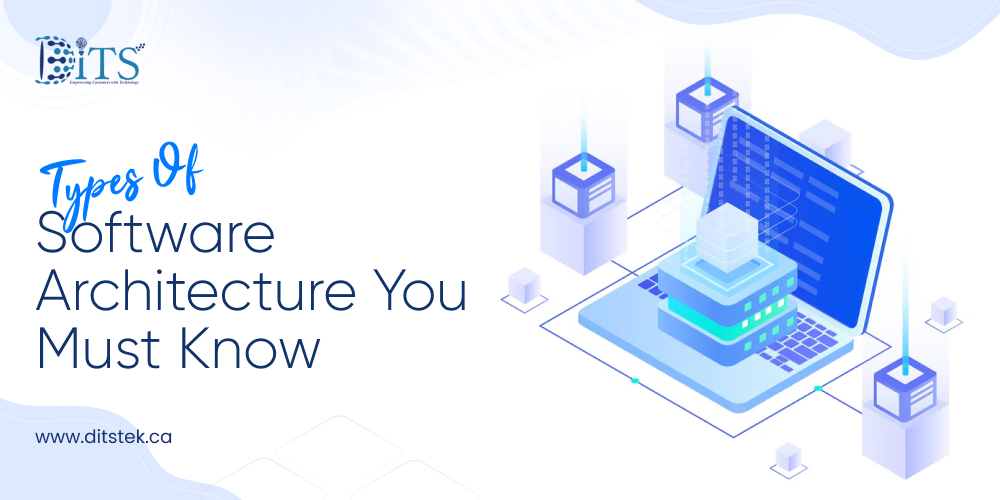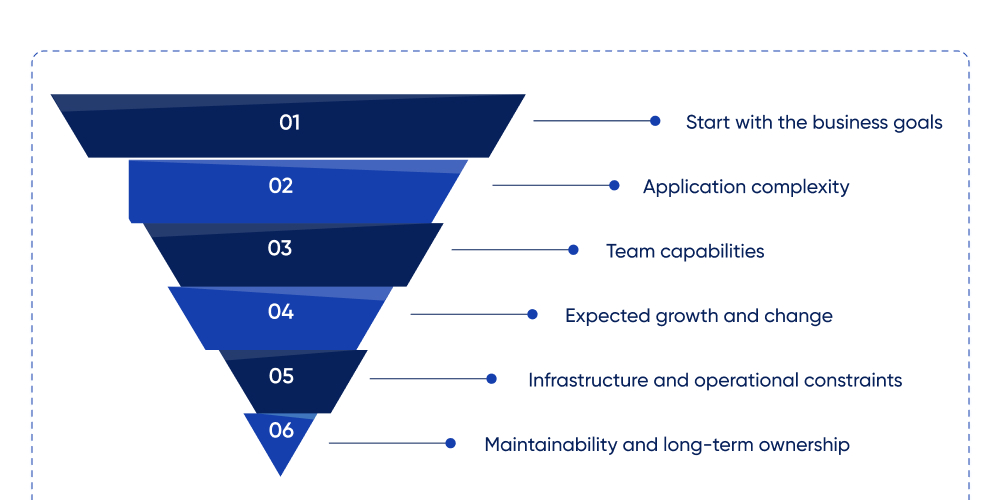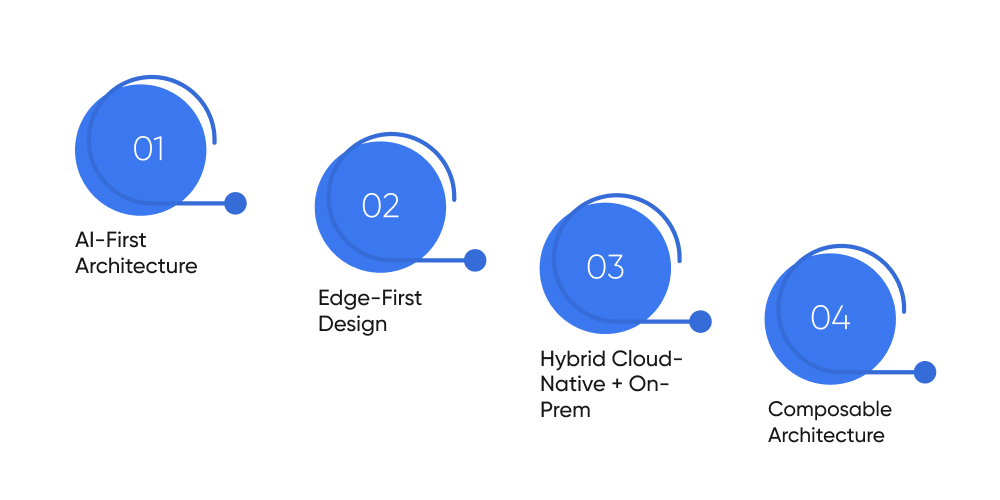Types Of Software Architecture You Must Know
Ditstek Blogs
Choosing the right software architecture decides whether your app scales smoothly or collapses under its own weight.
It’s not just a backend decision. Architecture defines how your system thinks, communicates, and adapts to change. It shapes performance, maintainability, security, and even how quickly your team can deliver new features.
This isn’t something you figure out halfway through development. It’s a foundation. And if you're planning a new software project, the architecture you choose early on will echo throughout its lifecycle. Some patterns offer speed but compromise flexibility. Others scale beautifully, but come with complexity. Knowing which is which, that’s the difference between building a product that grows effortlessly and one that constantly fights back.
This guide walks you through the types of software architecture that matter, what they look like, where they fit best, and how to choose the right one for your business.
Let’s get into it.
Need Help Choosing the Right Architecture?
Selecting the right software architecture can make or break your product. Get expert guidance tailored to your specific use case.
What is Software Architecture?
Software architecture defines how different parts of the software are organized, how they interact, and how data flows between them. It holds everything together. Which modules talk to which. Where responsibilities live. How requests move, how services scale, and how change is managed without breaking the whole thing.
It’s the structure behind the system,guiding how it’s built, how it behaves, and how it grows over time. And while you won’t see it in the UI or code snippets, it quietly shapes every decision that follows.
Architecture impacts delivery speed, team collaboration, testing, deployment, and long-term maintenance. Even the best code struggles if it’s built on the wrong foundation.
Why Software Architecture Matters
Architecture is a long-term investment in how your software performs, evolves, and holds up under pressure.
It shapes critical decisions:
– How easily new features are added
– How the system handles growth or spikes in traffic
– How teams collaborate without stepping on each other’s code
– How secure, stable, and testable the system is from day one
These decisions affect delivery speed, product strategy, and user trust.
Good architecture reduces friction. It keeps things predictable, even when requirements change. It helps avoid cascading failures and costly redesigns later on.
And once it’s in place, it becomes hard to undo so getting it right from the start is necessary.
Top Types of Software Architecture

Each type is built to solve a different set of problems, some prioritize speed, others favor flexibility, resilience, or simplicity. The right fit depends on what you're building, how fast it needs to scale, and how your team works.
Here are the most widely used and business-relevant architecture types worth knowing:
1. Layered Architecture (N-tier)
One of the most widely used and easiest to structure layered architecture splits your software into separate layers, each with a clear responsibility.
Typical layers include:
- Presentation layer (UI)
- Business logic layer (rules, workflows)
- Data access layer (database handling)
- Sometimes a service or integration layer
Each layer interacts only with the one directly above or below it. That separation makes the system easier to manage, test, and update.
Where it fits well:
- Internal enterprise systems
- Apps with clearly defined business processes
- Projects with multiple teams working in parallel
Strengths:
- Simple, predictable structure
- Easy to onboard and maintain
- Clear separation of concerns
Trade-offs:
- Can become rigid as complexity grows
- Adds latency through layer-to-layer communication
- Less flexible for real-time or event-heavy systems
If you’re building something with a stable scope and clear workflows, layered architecture is a solid place to start.
2. Event-Driven Architecture
Instead of having components constantly check in or rely on direct calls, event-driven architecture lets them react to events as they happen. One service emits an event, and any other service that cares about it can respond without tight coupling.
It's built around two core roles:
- Event producers: components that generate events (like “order placed”)
- Event consumers: components that listen for and react to those events
Events are typically passed through a message broker or event bus (like Kafka, RabbitMQ, or AWS SNS), which decouples services and allows them to scale independently.
Where it fits well:
- Real-time systems (chat apps, stock trading, fraud detection)
- IoT platforms
- Systems that need to scale under unpredictable load
Strengths:
- Highly decoupled and scalable
- Great for real-time responsiveness
- Easy to plug in new features without disrupting the core
Trade-offs:
- Can be harder to debug and trace
- Event flow gets complex without strong governance
- Requires careful design to avoid “event spaghetti”
If your system needs to react fast and stay flexible without being locked into rigid workflows, event-driven architecture can bee a powerful approach.
3. Microservices Architecture
Microservices break your application into small, independent services each responsible for a single feature or business function. These services communicate through APIs, often over HTTP or messaging queues.
Each microservice runs in its own process, can be deployed independently, and can even use a different tech stack if needed. That flexibility is the core strength of this architecture.
Where it fits well:
- Large, complex applications with evolving requirements
- Teams working on separate modules
- Cloud-native systems that need to scale specific functions independently
Strengths:
- Services can scale independently
- Faster development and deployment cycles
- Easier to maintain and test smaller pieces
Trade-offs:
- More moving parts means more operational overhead
- Requires strong DevOps and monitoring practices
- Distributed systems introduce network complexity and potential failures
Microservices shine when your system needs to grow fast, change often, and scale selectively. But without proper planning, they can create more chaos than clarity.
4. Client-Server Architecture
One of the oldest and most straightforward patterns, client-server architecture separates the system into two core parts:
- Client: the front-end that interacts with the user
- Server: the back-end that processes requests, handles business logic, and manages data
The client sends requests; the server responds. That’s the basic contract. Most web and mobile apps still follow this structure often layered with modern additions, but the core idea remains the same.
Where it fits well:
- Traditional web and mobile applications
- Internal tools and admin panels
- Any system with a centralized backend
Strengths:
- Simple and easy to implement
- Centralized control over data and logic
- Works well for most small to mid-sized applications
Trade-offs:
- Single point of failure if the server goes down
- Doesn’t scale well for large, distributed systems
- Less resilient than modern, decentralized architectures
Client-server may not be cutting-edge, but it's still a practical foundation for countless software projects especially when simplicity and control matter more than complexity and scale.
5. Monolithic Architecture
Monolithic architecture means everything from the UI, business logic, to data access layer lives in one tightly coupled codebase, deployed as a single unit.
All features, modules, and services are part of the same application. If one piece needs an update, the whole thing gets redeployed. It may sound outdated, but monoliths are still a valid choice in many scenarios.
Where it fits well:
- Startups building an MVP
- Small teams that need to move fast
- Applications with a tightly bound feature set
Strengths:
- Simple to develop, test, and deploy
- Less operational overhead
- No service orchestration needed
Great for early-stage products or proof-of-concept builds
Trade-offs:
- Harder to scale specific parts of the app
- A single bug can affect the entire system
- Can become a “big ball of mud” if not managed well
Monolithic doesn’t mean messy but it can get there quickly if the codebase lacks structure. Still, for small apps or teams that need speed over complexity, a clean monolith is often the fastest path to launch.
6. Service-Oriented Architecture (SOA)
Service-oriented architecture structures your software as a collection of services that communicate over a network. Each service handles a specific business function and shares data through a common protocol, often SOAP or REST.
Unlike microservices, SOA tends to rely on a centralized system for service orchestration and often shares components like authentication, logging, or messaging systems across services.
Where it fits well:
- Large enterprise systems
- Organizations with legacy infrastructure
- Systems that need to integrate multiple apps or departments
Strengths:
- Encourages reuse of existing services
- Easier integration with legacy modernization systems
- Standardized interfaces and shared governance
Trade-offs:
- More heavyweight than microservices
- Centralized coordination can become a bottleneck
- Can introduce tight coupling through shared components
SOA works well when you're dealing with complex, cross-functional enterprise needs, especially where integration and reuse take priority over agility or granular scalability.
7. Microkernel Architecture (Plugin-Based)
Microkernel architecture also known as plugin-based architecture focuses on a minimal core system with the ability to add or remove features as plugins.
The core handles the essential functionality, while plugins extend the system without modifying the core itself. This makes it ideal for applications that need to be highly customizable or evolve frequently.
Where it fits well:
- Platforms or tools that need to support third-party extensions
- IDEs, CMS platforms, or product suites with modular features
- Systems where not every user needs every feature
Strengths:
- Flexible and easy to extend
- Clean separation between core and add-ons
- New features can be added without risking core stability
Trade-offs:
- Plugin coordination can get complex
- Requires a well-defined interface between core and extensions
- Testing all plugin combinations can be time-consuming
Microkernel is a solid choice when you're building a product that needs to adapt to different users or industries without bloating the entire system for everyone.
8. Space-Based Architecture
Space-based architecture is designed for systems that need to handle high-volume, high-concurrency workloads without a single point of failure. Instead of relying on a central database or server, it distributes both processing and storage across multiple nodes or “spaces.”
Everything is split: data, logic, and even user sessions. This removes bottlenecks and allows the system to scale horizontally, often in-memory, for extreme performance.
Where it fits well:
- Financial systems (trading platforms, payment gateways)
- Online gaming or betting platforms
- Any system that must support heavy, unpredictable loads
Strengths:
- High scalability and fault tolerance
- Eliminates traditional database bottlenecks
- Designed for real-time performance under load
Trade-offs:
- Complex to design and configure
- Not suitable for every use case especially small apps
- Requires deep architectural planning and monitoring
If your system needs to stay fast under pressure and downtime isn’t an option, space-based architecture offers the kind of resilience that traditional models struggle to match.
9. Serverless Architecture
Serverless doesn’t mean “no servers”, it means you don’t manage them. With serverless architecture, your code runs in short-lived functions, triggered by events. The cloud provider handles all the infrastructure, scaling, and availability behind the scenes.
You only pay for the compute time your functions use. No idle resources. No provisioning. Just code that runs when needed.
Where it fits well:
- Lightweight APIs and backends
- Startups and MVPs that need to move fast
- Event-driven systems (notifications, file processing, background tasks)
Strengths:
- No infrastructure to manage
- Automatic scaling
- Cost-effective for low or variable workloads
Trade-offs:
- Cold start latency for infrequently used functions
- Vendor lock-in risks
- Limited execution time and resource constraints
Serverless is great when you want to focus on logic, not infrastructure. But it’s not ideal for long-running processes or systems that need fine-grained control over runtime environments.
10. Peer-to-Peer (P2P) Architecture
In a peer-to-peer architecture, there’s no central server. Every node (or peer) in the network acts as both a client and a server, sharing resources, data, or services directly with other peers.
This decentralized approach increases resilience and reduces dependence on any single node. If one peer drops out, the system keeps running.
Where it fits well:
- File-sharing platforms (e.g., BitTorrent)
- Blockchain and distributed ledger systems
- Collaborative platforms with local-first logic
Strengths:
- Highly fault-tolerant and resilient
- No central bottleneck or single point of failure
- Distributes load and storage across the network
Trade-offs:
- Harder to secure and govern
- Data consistency and synchronization can get tricky
- Performance can vary based on network conditions
P2P makes sense when decentralization is a feature, not a compromise especially in systems that rely on trustless interactions or distributed control.
11. Pipe-and-Filter Architecture
Pipe-and-filter architecture structures your system as a series of independent processing units called filters connected by data streams, or pipes. Each filter performs a specific transformation, passing its output to the next.
Think of it like an assembly line: raw input goes through multiple filters, each handling one step, until the final result is produced.
Where it fits well:
- Data processing pipelines
- Compilers and interpreters
- Audio/video streaming and transformations
Strengths:
- Easy to scale or parallelize filters
- Highly reusable and testable components
- Clear, linear data flow
Trade-offs:
- Can add latency if filters aren’t optimized
- Debugging across multiple stages may be complex
- Not ideal for highly interactive or stateful applications
If your application processes data in multiple steps, such as transforming, enriching, validating, and then outputting it, the pipe-and-filter model keeps the design clean. Each step is handled by a separate, focused unit, making the system modular and easier to understand.
12. Component-Based Architecture
Component-based architecture focuses on building software using modular, reusable components. Each component is a self-contained unit that encapsulates its logic, UI, and state, and communicates with other components via well-defined interfaces.
It’s commonly used in front-end development (think React, Angular), but the principles apply across systems where reusability, separation of concerns, and flexibility are key.
Where it fits well:
- UI-heavy applications with repeatable elements
- Low-code platforms or configurable enterprise tools
- Systems that evolve through feature add-ons or customizations
Strengths:
- Highly reusable and easy to test
- Encourages clean separation of concerns
- Speeds up development through prebuilt modules
Trade-offs:
- Requires upfront planning for component design
- Managing shared state across components can get messy
- Overuse can lead to fragmentation if not well-coordinated
If your product needs to be flexible, customizable, or extended over time, component-based architecture offers the structure and scalability to support that growth.
Wondering Which Architecture Suits Your Startup?
Not all frameworks are startup-friendly. Discover the most scalable software architectures for your growth stage.
How to Choose the Right Architecture?

The “best” architecture depends on what you’re building, how your team works, and what kind of change the system needs to support over time.
Here’s what to consider:
1. Start with the business goals: Start with what the application is expected to achieve. Is rapid delivery the priority? Long-term scalability? System stability? The architecture should align with these goals.
2. Application complexity: Simple applications don’t require complex architectural patterns. A monolith may be appropriate for a lightweight internal tool, while a high-traffic, modular platform may benefit from microservices or event-driven design.
3. Team capabilities: Architecture decisions should reflect the skill set of the development and DevOps teams. Introducing distributed systems without the necessary expertise often leads to technical debt and instability.
4. Expected growth and change: Design for current needs with a clear path for evolution. Over-engineering early-stage applications adds unnecessary complexity without delivering immediate value.
5. Infrastructure and operational constraints: Consider what your team can support from an infrastructure standpoint. Some architectures require robust CI/CD pipelines, monitoring tools, and orchestration platforms. Others are more straightforward to deploy and manage.
6. Maintainability and long-term ownership: Think beyond the initial build. How easy will it be to test, troubleshoot, and extend the system 6 or 12 months from now?
Emerging Architecture Trends in 2025

As systems grow more intelligent, distributed, and modular, architecture is evolving to match. While core patterns remain relevant, new approaches are shaping how modern software is designed, deployed, and scaled.
Here are some key trends to watch:
1. AI-First Architecture
Systems are increasingly built with AI capabilities at the core. This includes deep integration with LLM APIs, real-time inference pipelines, and architecture patterns optimized for data-driven workflows.
2. Edge-First Design
To reduce latency and improve responsiveness, more architectures are moving compute closer to users at the edge. This is especially relevant for IoT platforms, AR/VR applications, autonomous systems, and real-time analytics where milliseconds matter.
3. Hybrid Cloud-Native + On-Prem
Enterprises are adopting hybrid models that combine cloud-native scalability with on-prem infrastructure either for HIPAA compliance, data sovereignty, or performance reasons.
4. Composable Architecture
In eCommerce, CMS platforms, and enterprise suites, composable architecture is gaining traction. It emphasizes modularity where individual services (like search, payments, content, or checkout) are decoupled and connected via APIs. This allows businesses to build flexible, best-of-breed solutions that evolve quickly.
Need Help Modernizing Legacy Systems?
Legacy systems can bottleneck innovation. Let’s help you re-architect with modern patterns that actually work.
Real-Life Examples by Architecture Type
Understanding architectural patterns is one thing, seeing where they’re applied at scale brings the concepts to life. Below are real-world examples of how well-known platforms align with specific architectures:
Netflix → Microservices
Netflix famously transitioned from a monolith to microservices to support rapid scaling, independent deployments, and fault isolation across global services.
Dropbox → Client-Server
Dropbox’s core sync and storage system follows a traditional client-server model, where the desktop client communicates with a centralized backend to manage file versioning and storage.
AWS Lambda → Serverless
Lambda is a textbook example of serverless architecture running event-driven functions that scale automatically, without any infrastructure management by the developer.
Visual Studio Code → Microkernel
VS Code is built around a lightweight core with support for plugins and extensions, allowing developers to customize functionality without modifying the core system.
Final Thoughts
What works for a startup MVP may not work for a high-traffic enterprise platform. And what’s trending isn’t always what’s right.
Aim for the balance: simplicity where possible, scalability where needed.
Architecture shapes performance, cost, adaptability, and speed of delivery. When chosen deliberately, it sets the foundation for growth. When ignored, it becomes a bottleneck.
At Ditstek Innovations, we help businesses design software systems that are resilient, scalable, and built to adapt. Whether you're modernizing a legacy platform or building a product from scratch, our team can help you choose and implement the right architecture for your vision.
FAQs
1. Which architecture is best for a startup MVP?
A monolithic or layered architecture often works best for early-stage products due to simplicity and speed. As the product matures, it can evolve into more distributed patterns.
2. When should we move from monolith to microservices?
When parts of your application need to scale independently, deployments become risky, or teams are blocked by tight coupling, it may be time to transition to microservices.
3. What architecture does DITS recommend?
We don’t believe in one-size-fits-all. At DITS, we evaluate your business goals, team capabilities, and long-term roadmap to recommend the most suitable architecture, whether that’s serverless, microservices, layered, or a hybrid model.
4. Can DITS help modernize our legacy software architecture?
Yes. We specialize in re-architecting legacy systems by breaking down monoliths, enabling cloud-native deployments, and ensuring minimal disruption to existing operations.
5. Does choosing a complex architecture increase project cost?
Not always. Poorly chosen architecture whether simple or complex tends to cost more in the long run. The key is to design for current needs with a path for future growth. That’s what we help clients achieve.
6. How involved is DITS during architecture planning?
Very. Architecture planning is a core part of our software development process. We collaborate with your stakeholders, define system goals, and ensure the architecture supports both short-term execution and long-term scalability.

Dinesh Thakur
21+ years of IT software development experience in different domains like Business Automation, Healthcare, Retail, Workflow automation, Transportation and logistics, Compliance, Risk Mitigation, POS, etc. Hands-on experience in dealing with overseas clients and providing them with an apt solution to their business needs.
Recent Posts
Get in touch










